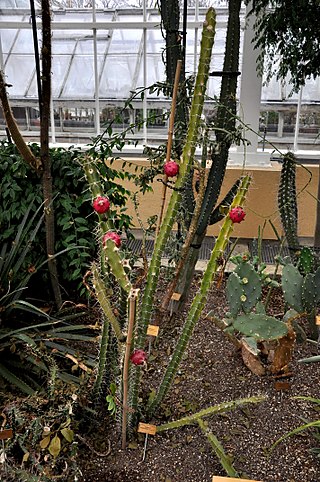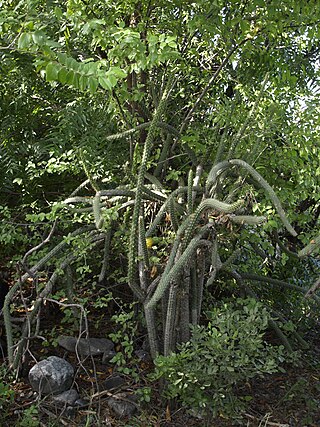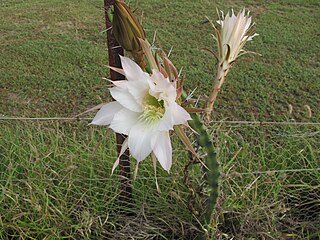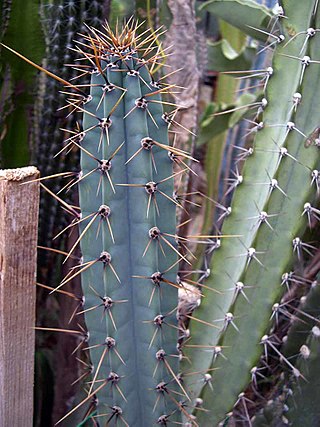
Stetsonia coryne, the toothpick cactus, is the sole species in the cactus genus Stetsonia. Stetsonia coryne grows to a height of 15 to 25 ft tall. It has white flowers.

Harrisia is a genus of night blooming cacti.

Harrisia aboriginum, the west-coast prickly apple or prickly applecactus, is a species of columnar cactus endemic to peninsular Florida, on the Gulf Coast of the counties of Lee, Sarasota County, and Charlotte. Only 12 occurrences are known, and the species is threatened by horticultural collection, shading from fire suppression, competition from invasive flora, and most of all habitat destruction. It is a federally listed endangered species of the United States.

Harrisia bonplandii is a species of cactus. The cactus plants in the Gran Chaco are generally called tuna and this specific variety reina de la noche. Fruits and roots are edible and well known to the native nations of the Gran Chaco.

Harrisia divaricata is a species of cactus endemic to Hispaniola.
Harrisia gracilis is a species of cactus found in Jamaica.

Harrisia fragrans is a rare species of cactus known by the common name fragrant prickly apple. It is endemic to Florida, where it is known only from St. Lucie County. The plant's habitat has been almost completely consumed by development, leading to its rarity. It is a federally listed endangered species of the United States.

Harrisia pomanensis is a species of cactus.

Pereskia aculeata is a scrambling shrub in the family Cactaceae. Common names include Barbados gooseberry, blade-apple cactus, leaf cactus, rose cactus, and lemonvine. It is native to tropical America. The leaves and fruits are edible, containing high quantities of protein, iron and other nutrients, and it is a popular vegetable in parts of the Brazilian state of Minas Gerais under the name of ora-pro-nóbis.

Lophocereus schottii, the senita cactus, is a species of cactus from southern Arizona and north-western Mexico, particularly Baja California and Sonora.

Harrisia tortuosa is a species of cactus in the Trichocereeae tribe.

Cereus aethiops is a species of cactus found from Uruguay to Argentina.

Cereus forbesii is a species of columnar cactus whose native range is Bolivia to N. Central Argentina.

Mirabella estevesii, synonym Cereus estevesii, is a species of columnar cactus found in Minas Gerais, Brazil. The first description was published in 2004 by Pierre Josef Braun as Cereus estevesii.

Neoraimondia arequipensis, synonym Neoraimondia macrostibas, is a tree-like cactus native to western Peru. It was first described in 1835 as Cereus arequipensis.

Cleistocactus smaragdiflorus is a species of Cleistocactus found in Bolivia and Argentina.

Harrisia brookii is a species of cactus found in the Bahamas.

Harrisia tetracantha is a species of cactus found in Bolivia.
Harrisia adscendens is a species of cactus found in Brazil.

Harrisia eriophora is a species of cactus found in Cuba.





















